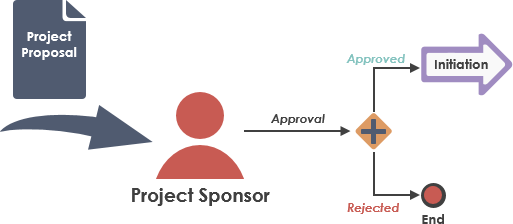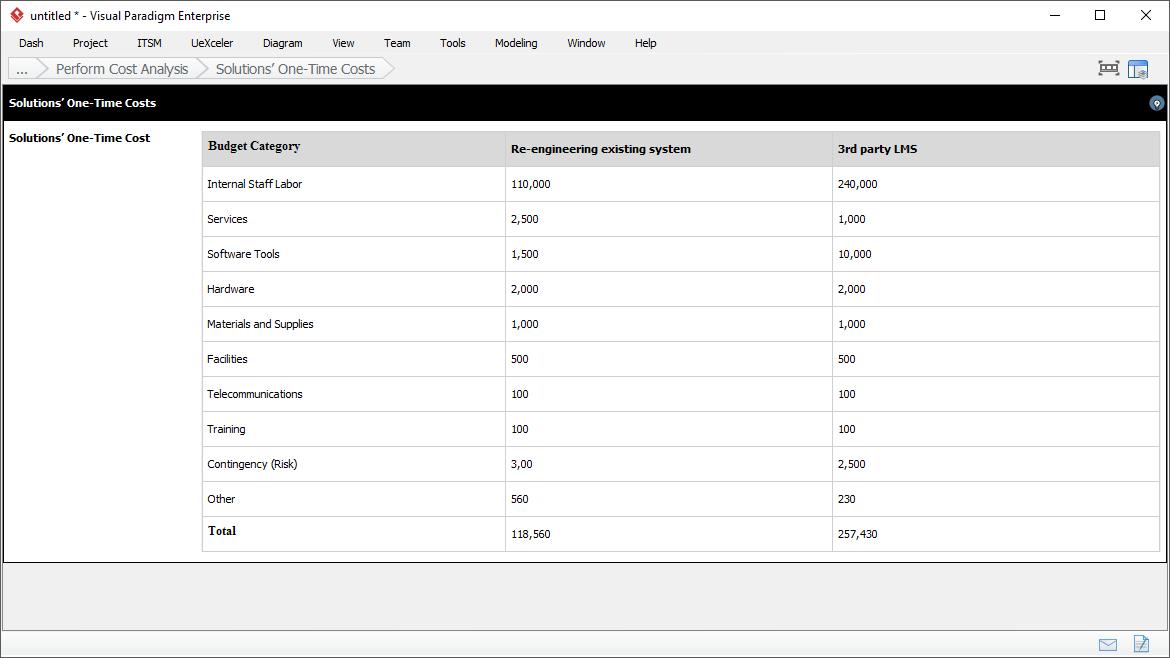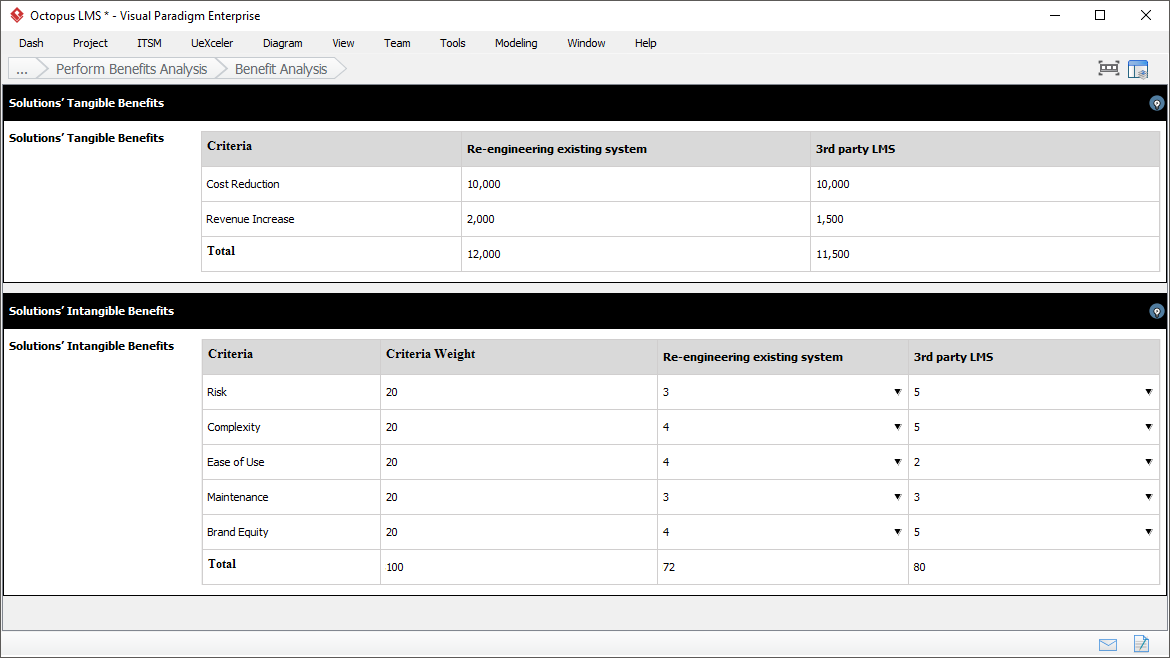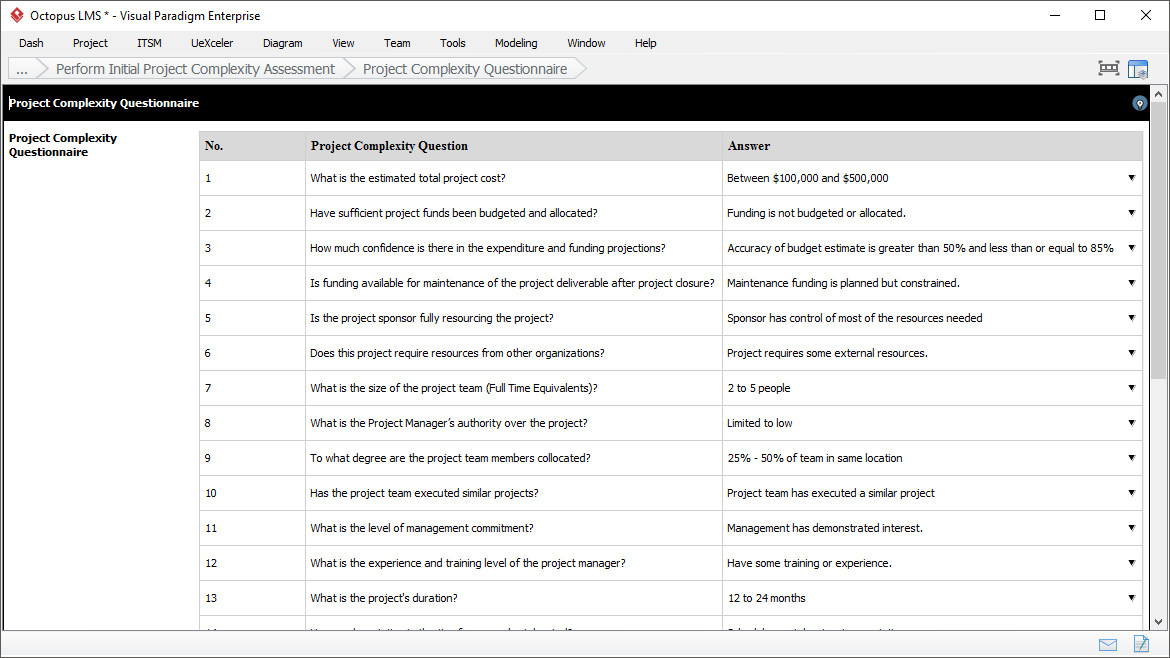Typically, a project is proposed by an individual who identifies a project-worthy need or opportunity. The Identification phase of the IT Project Management Framework involves evaluating and deciding if a proposed project should be undertaken, based on the studying of factors like costs, benefits, risks, and etc.
A quick walk-through

The Identification phase is initiated by the project sponsor, who generates the need of an IT project and is responsible for the project proposal, or sometimes referred to as a business case. The project proposal is a document that describes what needs to be done, why is the project worth doing and the overall strategies that enable the project to be accomplished.
Generally, a project proposal contains contents like:
- The statement of need that describes the purpose of the project. This could be a business problem being solved or an opportunity for an improvement from a customer's perspective.
- Cost estimate of various possible solutions, along with a recommendation in the end.
- A high level time frame of the project that lists out the major milestones of the project, which covers possibly only the start and end of project, and other known and foreseeable events.
- And a list of risks to which the project will be exposed.
Although the project proposal is the responsibility of the project sponsor, the preparation is often a combined effort of the sponsor, business analyst and other related parties. Sometimes, the business analyst is the one who writes the project proposal.
So once the proposal is written, the project sponsor evaluates it to ensure project costs and benefits are weighed before a commitment of resources is made and that the project to be taken will create value to the organization.
If the proposal failed to justify the project, the project sponsor will cancel the project. If the proposal is approved, this ends the Identification phase, and begins the Initiation phase.

Activities and deliverables
The table below lists the major activities of this phase and the deliverables (i.e. process documents) output from the activities.
| Activity | Description | Deliverable |
|---|---|---|
| Cost Benefit Analysis | the assessment of cost and benefits related to each solution | Cost Benefit Analysis |
| Risk Assessment | To assess the risks associated with the project. A project with high risk may imply a higher chance that it will end with a failure, which is a factor to consider in approving the project proposal. | Risk Assessment |
| Initial Project Complexity Assessment | To determine the complexity of the project by answering a questionnaire. This process helps you understand not only the scale of project but also the readiness of the team in conducting the project. | Project Complexity Assessment |
| Develop Project Proposal | Develop project proposal, which is document that describes what needs to be done, why is the project worth doing and the overall strategies that enable the project to be accomplished | Project Proposal |
| Approve/Reject Project Proposal | Project sponsor decides or denies the project proposal |
Cost Benefit Analysis
Cost Benefit Analysis is the estimation of the total costs and possible profits to be derived from a project, through the adoption of different solutions.
Cost Benefit Analysis begins with the identification of possible solutions. Based on the project description, statement of business need and business objective(s), identify a range of solutions that can be considered to address the identified need. For each possible solution, identify its cost and benefits.
Cost Analysis
Cost analysis must include both one-time and on-going cost, which is also known as recurring cost. One-time costs are also known as capital expenses, which are not incurred on regular basis. And once incurred they give long term benefit. On the other hand, on-going costs are regular costs that incur on regular basis.
Examples of one-time costs include facilities, equipment, hardware, software, training and personnel. Example of on-going costs include the maintenance cost of system, which is often counted on annual basis, security cost, data storage service, on-going customer technical supports, etc.
Once you've identified the cost items, estimate the costs required for each item, for each possible solution.

Benefit Analysis
There are two kinds of benefit, tangible and intangible. Tangible benefits are benefits that can be measured and quantified. Typically it refers to a reduction in cost and an increase in potential revenue. Intangible benefits are non-quantifiable improvements like risk, ease of use, brand equity, etc.
To evaluate the intangible benefits of possible solutions, a weighted evaluation will be performed. Firstly, identify the criteria as needed. In this example we have enhanced user experience, increased customer satisfaction, compliance and brand equity. Then, choose a weighting between 0 and 100% for each of the criteria. Make sure the total weighting is 100%. After that, rate each solution between 1 and 5 for each criteria, with 1 as the lowest rating, 5 as the highest. The weighted average rating for each solution will be obtained.

Based on the cost and benefits analysis, recommend a solution. State why the preferred option was chosen by summarizing its benefits and costs, and explain why the benefits outweigh the costs involved. You should also state assumptions that have been made in choosing the preferred option, and outline the business process changes required to adopt the solution.
Risk Assessment
Projects always carry risk, i.e. uncertainty. The purpose of risk assessment is to judge the benefits of the proposed project to be worth the risks involved in undertaking it.
Typically there are two main sources of risk. The first source is about dealing with something new, e.g. to adopt new technologies, to work with new partners, and to apply new processes or working procedures. The other common source of risk is dependencies, e.g. availability of resource, the need to integrate with another system and the need of stakeholder commitment, etc.
Well-identified risks are ones that can point out the possible problem clearly. It's specific, clear and have no ambiguity. Here are some good examples:
- The new system may not be compatible with the old CRM
- The severe weather condition may slow down the progress
- The holiday leave of CIO in Feb may affect decision making
- The cost estimates may be inaccurate due to the fluctuation of exchange rate
Well-identified risks help decision makers determine the consequence and the severity of the risk. And if it's decided that the project will be undertaken, the team can identify the strategies and actions to resolve and mitigate the risk.
In contrast, here are several poor examples risks:
- Inaccurate cost estimate.
- The project may run out of budget.
They are just statements, and perhaps something that had happened or happening. No matter what, they are not risk. A risk must identify the uncertainty that lead to the risk. By reading these statements we have no idea under what circumstance the project would run out of budget. No one can derive meaning action or make any decision.
Besides the identification of project risks, risk assessment also involves the studying of security considerations. You need provide a brief summary of the impacts and concerns related to IT Security.
Initial Project Complexity Assessment
If your project is about developing a simple tic-tac-toc game, it may seem a bit overkill to perform management activities for budget, procurement, staffing resources, right? In the IT Project Management Framework, there is a classification mechanism that helps identify your project's complexity, which determines the activities required to perform.
The classification mechanism involves the answering of a project complexity questionnaire. By answering a set of complexity questions, a total score along with a classification of project complexity will be obtained. Listed below are the factors that constitute the assessment of project complexity. Questions in the questionnaire are set based on these factors.
- Costs, funding and budget
- Project team attributes and personnel commitment
- Scheduling, dependencies, and duration
- Project impacts
- Novelty of solution
- Degree of end user involvement
- Data conversion need
Three factors weighted most heavily are the cost and funding of a project, project team's attributes and personnel commitment, and the project's impacts.

Project classification takes place in the Identification phase and is revisited later in the Initiation phase, by the project manager. In the Identification phase, classification is performed to identify project funding status and project risks. The project nature as identified through answering the questionnaire also gives the performing organization ideas in choosing the candidates of project manager. In the Initiation phase, classification is revisited by the project manager. A decision of project scheme will be made accordingly.
Develop Project Proposal
By the end of the Identification phase, the project sponsor evaluates the proposal and decide whether to approve it or not. If approved, the project is said to be identified. The initiation phase will then begin. If rejected, the project will be terminated. The following sections describe the contents of a typical Project Proposal in detail.
Project Summary
Project summary provides a description of the project and the business needs it intends to fulfill. It describes the unmet need, demand for services, or opportunity identified underlying the need for an IT project. It consists of three parts.
- Project Description: An overview of the history behind the project. You may also include the description of requests made by the project sponsor underlying the need for an IT project.
- Statement of Need or Opportunity: Describe the purpose of the project. This could be a business problem being solved or an opportunity for an improvement from a customer's perspective. The business problem can be a question, issue, or situation, pertaining to the business, which needs to be answered or resolved.
- Business Objective(s): The desired result produced by a project that answers or resolves the business problem. Define the specific business objectives of the project and correlate them to the strategic initiatives or issues identified.
Description of Project Initiator / Sponsor's roles and responsibilities
Project Initiator is the person from whom the project idea originated. Project sponsor is the person who has the authority to overcome major obstacles to completing the project, which includes defining project goals, securing resources, and resolving conflicts. Sometimes, the two roles are played by the same person, especially when the projects are originated internally. However, it is not necessarily always the case.
Project Initiator vs Project Sponsor
The role of project initiator is to initiate a new project to fulfill someone's needs. It is not a formal role, in fact, any person who suggests the need of a project is a project initiator. Such a role may not even have any responsibilities nor involve actively throughout the project management lifecycle.
Once the project has been initiated (by project initiator), project sponsor take the role to assign the project to the project manager, and to support the project continuously until the project is complete.
Project sponsor has the authority to overcome major obstacles to completing the project, which includes defining project goals, securing resources, and resolving conflicts. He or she approves the project proposal and project charter and provides the formal sign-off for acceptance of a project's final deliverable(s).
Customers and Final Deliverables
Identify who will benefit from this project including the customers and beneficiaries of the effort.
- Customer: is the person or organization who will pay for the final deliverables that satisfies an unmet need.
- Beneficiary: is the person or organization who will benefit from the value created by the final deliverable. He/she/they may not be the one to pay for it.
Besides, list and describe the final deliverables, which are the key outputs of the project, expected to be ready by the end of the project. Typically, a deliverable is a software product, an IT system, a major piece of system function, or even well-defined processes, etc.
Project Approach
Describes the strategies that enables a project be planned, executed and completed.
Resource Requirements
Identify the resources (human, physical, other) and skills required to complete this project. Here are some examples.
- Funding: Estimate the funding required for the project. You may reference the result of cost and benefit analysis performed in the Identification phase.
- Customer Support: Describe how customers will be involved in the project.
- Facilities: Describe the facilities required for project (e.g. conference room, data center)
- Equipment: Describe the hardware needed for the project (e.g. printer, scanner).
- Software Tools: Describe the software requirements for the project.
Although detailed resource requirements will be identified in subsequent phases, it is important for the project proposal to include the level of detail sufficient for the authorizing party to make sound judgments about the appropriation of resources.
Project Success Criteria
Specify the project success criteria, which are the principles or standards used to determine or judge project success.
While it seems obvious that to deliver what the customer want on time and within budget would be considered success, in practice there are usually way more criteria in determining project success. One customer may be willing to sacrifice features for a quicker availability of solution, another may see the completeness and stability as the key criteria, and is willing to extend the project period to achieve these. The customers in both cases get what they want and thus, both are considered a success.
Critical Success Factors
Specify the Critical Success Factor (CSFs), which are the conditions, capabilities, events, and circumstances that contribute to project success. The purpose of identifying the critical success factors is to ensure that the project success criteria defined can be met. Here are some examples:
- Product innovation capability
- Testing talent
- Commitment from key stakeholders
- Patent protection (which secures the project's long term success)
Project Success Criteria vs Critical Success factors
Project success criteria and critical success factors are often used interchangeably but they refer to two different concepts. Here are their definitions:
- Project Success Criteria are the principles or standards that will be applied to determine or judge project success. Only when a project can meet the criteria is said to be a success.
- Critical Success Factors are the conditions, events, and circumstances that contribute to project success. Those are the factors that will lead to a project's success.
Recommended Solution
The solution recommended based on cost benefit analysis.
Project Risks Overview
The risks to which the project will be exposed, based on risk assessment
Project Complexity Assessment
The answers of the project complexity questionnaire, along with a total score along with a classification of project complexity.


